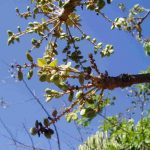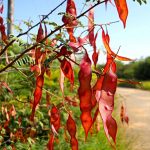TREE LIFE
February 1987
MASHONALAND CALENDAR
Tuesday February 3rd : Botanic Garden Walk. Meet at 1645 for 1700 hours
Sunday February 15th : A visit to Carolina Estate the home of Dave and Pauline Tomlinson who are developing a private game park. Naturally the trees are also being observed. We shall visit an area of granite with paintings and walling in the morning; have lunch at the house and visit an area near a water hole and in sight of Lake McIlwaine in the afternoon. No bus on this occasion. Meet at Monomatapa Car Park at 0900 to share transport. We will be travelling on farm roads which are in good condition. There will be a security guard to look after the cars and we shall ask everybody to contribute towards that cost as it is part of the Societies outing expenses.
MATABELELAND CALENDAR
This will be an outing to the Quiet Waters Conservation Project at Falcon College, Eigodini. As a central point, in case our Harare members stay at Matopos, the first meeting place will be the Hillside Service Station (BP), Corner Matopos Road, Cecil Avenue at 0800 hours. We will then travel along Cecil Avenue and turn right into the Old Esigodini Road. The second meeting place will be its junction with the Johannesburg Road, about 18km from Bulawayo, at 0830 hours for our destination arrival time of 0900 hours. This will be an all day trip and hopefully we can use the short cut across t0 the Harare Road from Falcon College.
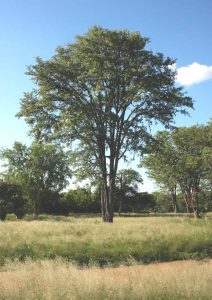
Colophospermum mopane. Photo: Bart Wursten. Source: Flora of Zimbabwe.
At our Glanville outing on 4th January we identified 60 trees in about 6 acres of bush and a short stretch of river bank. Acacias involved some research, but we decided they were Acacia fleckii, Acacia karroo, Acacia polyacantha and Acacia rehmaniana. There were several large Albizia amara and we were surprised to discover an Albizia harveyi. Clarodendrum glabrum were just starting to flower and on the river bank was a 18m Clarodendrum myricoides in flower and fruit. Combretum apiculatum, Combretum hereroense, Combretum imberbe and Combretum molle grew in close proximity as did 5 members of the Commiphora family, C.africana, C.mollis, C.mossambicensis, C.pyracanthoies and C.schimperi. Mundulea sericea were covered in seed and there were several Bauhinia thonningii bushes. We had some difficulty tracking down the botanical name of the mopane,
Colopospermum mopane, which we rarely see on our outings. Dichrostachys cineria is spreading rapidly in the area and were in flower; Grewia flavescens and Grewia monticola were in flower and seed and a large Lonchocarpus capassa, which was uprooted in heavy rain about 10 years ago is still full of leaf. Ximinia caffra and Ximenia americana were both found. We sampled fruit from various trees and bushes under the assurances of our intrepid taster, Thora Hartley – and even though it was hot and dry we had a very interesting and pleasant morning.
Betty Blake
BOTANIC GARDEN WALK, JANUARY 1967 : THE GENUS DIOSPYROS OF THE FAMILY EBENACEAE
Ever since the queen pricked her finger and wished for a daughter with ebony hair, blood red lips and snow-white skin we have learned to call all fine grained black wood ebony. In Zimbabwe Dalbergia melanoxylon is most often mistaken for an ebony although it is a legume. It does make good wind instruments and has been exported for producing parts for the bagpipes. The commercial ebony is a very hard wood either from Diospyros enenum, Sri Lanka, or D.reticulata, Mauritius. These are used for piano keys, interestingly the Oxford Dictionary states the origin of the word ebony as perhaps after ivory. The dark colour of ebony results from the production of dark coloured naphthaquinones or their derivatives. These are deposited in the leaves, young stems and mature wood in many members of the family and so on this walk we looked out for these features. Heywood states that the outer bark of many species in the EBENACEAE is usually black, gritty and charcoal like; this too is related to the naphthaquinones.
The name Diosyros literally means “divine wheat” and apparently Pliny referred to Diospyros as the “seed of Jove”, Drummond 1981). These edible fruits refer to the persimmon of which there are two species. In the US a persimmon is the fruit of D.virginianum whereas the oriental persimmon comes from D.kaki. The fruits of most members of the EBENACEAE are usually juicy or somewhat leathery berries containing seed that are often patterned and have a very thin seed coat. This latter feature implies that they need to be planted fresh.
We began the walk in the Zambezi Valley section where Tom showed us his
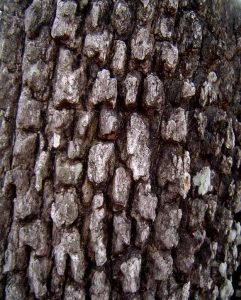
Diospyros quiloensis. Photo: Bart Wursten. Source: Flora of Zimbabwe.
Diospyros quiloensis which was too young to show the characteristic crocodile bark. This tree is common in the dry layered forest, jesse, and on the escarpment. Two vegetative features recur through the genus, firstly, a range of leaf sizes on the same twig and secondary an apical bud at the strange angle to the rest of the branch. The range of leaf sizes is not an exclusive feature for Diospyros, it occurs in many trees that have buds which are dormant for a period of time. When these dormant buds break they usually produce at least one very small leaf, and consecutive leaves gradually increase in size till the mature size is attained. If the tree grows in spurts and not continuously during the same rainy season then each spurt of growth shows the range in leaf sizes. Naturally species in seasonally dry habitats will show the feature better than species in forests. Meg mentioned that the leaves of D.quiloensis turn black when pressed and I suggested this may be due to iridoid compounds, which some of the more advanced plant families use as a deterrent for insects. This suggestion was wrong – the EBONACEAE do not have iridoid compounds, instead it must be the nephthaquinones. D.quiloensis is very difficult to grow and very slow growing in the Gardens. These specimens were just beginning to show the short lateral spurs that become sharp spines and could even puncture a Land Rover tyre.
Alongside the D.quiloensis is a tall but bushy D.lycioides, an evergreen species common around vleis and on anthills. There is quite a range of forms with different coloured fruit and seeds. Meg noted how depressed the veins are on the upper surface of the leaf, a feature we were to note in other members of the genus. Although the leaves are shiny they do have hairs, and these are another characteristic in the EBONACEAE. D.lycioides also develops spines from short lateral branches. This was the first species we found with a finely reticulate, very black bark.
Crossing the lawns and entering the forest behind the Ficus cheneodensis we came across the black trunk of D.ferrea, a species from all the old world tropical forests. It grows in the Chirinda Forest, Mermaids Grotto and the Haroni Valley but not beyond Chimanimani. As with a number of species of Diospyros there is often a yellow slash beneath the black bark. Alongside the Bequaertiodendron natalensis we found D.natalensis from the Bunga Forest where it grows to 30m. This forest form looks so very different to the form we usually see many of us were skeptical, but that is how Frank White has arranged them. These trees have elongate leaves with attenuate tips.
Moving to the Trichocladus we found D.abyssinica, yet another black bark which is also rough, an unusual feature for a forest tree. This is a very tall 55m tree on Mt. Selinda, usually with a clear trunk to 25m. The wood is useless, so much for being an ebony, and the leaves are bigger than D.ferrea. Tom has found one in the Vumba. Just around the Crysophyllum there is a small D.whyteana with its shiny leaves fringed with brown hairs this is a tall tree around Inyanga and in the Vumba, but closer to Harare it is generally shrubby. The fruit resembles a gooseberry with its large persistent calyx. Once again it has a lack bark with lemon under bark.
In the forest behind the Raphia palms Tom showed us another form of D.natalensis from forest edges with broad leaves. It seldom grows more than 7 – 8 m, is common on burial grounds and this specimen had a pale trunk. It was comforting to see the more usual form of this species, the one we remember as D.nummularia. The seeds of this species look like little acorns as we saw them in Concession recently.
A short run led us over to the SE Lowveld to find a knee high D.usambarensis, a large shrub on alluvial soils in woodland. It is widespread but not common and has shiny leaves, the bark and roots produce a black dye, but otherwise I think I would struggle to recognize it again. Still in the SE Lowveld and alongside an enormous Ficus stuhlmannii is a D.squarrosa with its brown bark that flakes off in strips. It grows in rock outcrops in the NE on schist and in the Zambezi Valley.
Between Ficus capreifolia and the heavily fruiting Dovyalis hispidula Tom has a tall D.senensis that was in flower. This also has acorn like fruit but those in the Valley were never very tasty. It is common along the flood plain and often fluted. It often grows alongside D.mespiliformis on the banks of the Zambezi, or more usually tributaries at the Zambezi. D.mespiliformis has the tastiest of all the local fruits and is eaten with great relish. Tom’s specimen is close to the lake. Moving towards the Ficus bubu and into the forest section we found D.sp. No. 1, now called D.holyleana. This species has two subspecies, one in East and one in West Africa. Ours occurs 1000km south of the East African population but is the same as that from Gabon and Nigeria.
There are only two species Tom has had no success with, D.kirkii, the large leaved species I have always mistaken for a Terminalia, and D.batocana, a small species from the Kalahari Sands. But now that Tom’s Baikiaea are growing there is hope for other Kalahari Sand species.
We must thank Tom once again for an interesting and lively walk.
-Kim Damstra.
ALAMEIN FARM, BEATRICE AND IRIDORE FARM, HARARE SOUTH, 18 JANUARY1987
The January outing was spent botanizing between showers. The original venue was the Watson-Smith’s farm, Alamein, that lies about 16km east-south-east of Beatrice. South of Beatrice there is a wide expanse of thick Karroo sediment that lies on top of the granitic and gneissic rocks which form the Basement Complex. We began on the northern edge of Alamein alongside the Mondoro Road. Here there are localized patches of sodic soil with Colophospermum mopane that were just coming into flower. The undergrowth on the patches is sparse and the shallow depressions in the bare soil were filled with standing water. A juvenile hinged terrapin of the genus Pelusios demonstrated its hinged shell as well as the most characteristic feature – a nauseating stench. These pools had only formed during the previous day but already they supported a population of fog’s eggs.
A diverse woodland lay between the mopane patches with four species of Combretum. The softly furry leaves on C.hereroense look just like grey green mouse ears whereas the large smooth leaves of C.apiculatum have a twisted apex. C.zeyheri has the largest fruit, and these had just started to swell up in preparation for growth. C.imbere has smaller fruit and the branches all stick out in an angular manner.
The increased moisture close to the stream resulted in the presence of a number of species that are more usually associated with termitaria. One notable example was a tall Cassine transvaalensis that was difficult to identify because the margins of the leaves were entire and not serrated. Most of the members in this family, the CELASTRACEAE, are characterized by serrated leaves, and young specimens of C.transvaalensis have leaves that are so serrated they are decidedly prickly and can be difficult to pick. As the tree ages the leaves become less serrated until it is difficult to prove that the leaves are not entire. The same trend occurs in a number of other indigenous trees, we were able to demonstrate it on a small Pappea capensis growing beneath the Cassine. This adaptation appears to prevent browsing animals from eating the young plants, but whether it really works still needs to be tested. In the shade of the C.transvaalensis a C.aethiopica with its rounder alternate leaves and in the afternoon we found the droopy, often opposite leaves on C.matabelica.
The rains forced us to re-board the bus and head for the farmhouse, but having overtaken the downpour we stopped again, this time on the Karroo sands. Here the well developed miombo woodland contained many of the characteristic sandveld species, including numerous Ochna pulchra, tall Monotes glaber, clusters of Catunaregum spinosa and a new species for many of us in the form of Strychnos pungens. The small hard leaves on this species terminate in a distinctive needle lie spine. It is common in this woodland with a number of large specimens. Once again we were forced to run for cover and so made our way to the house for tea and lunch.
The next break in the rains allowed us to inspect the garden where we found at least three of the mopane fence posts that surrounded the duck ponds had sprouted new leaves and begun to grow. This was their second season of growth and it will be interesting to see whether they are able to form new trees in a few years time. Around the side of the house a large
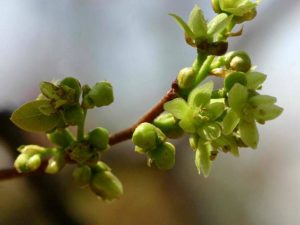
Pseudolachnostylis maprouneifolia. Photo:Bart Wursten. Source Flora Of Zimbabwe.
Pseudolachnostylis maprouneifolia looked remarkably like a Hexalobus, the distinguishing feature beig the deciduous stipules that are characteristic of the EUPHORBIACEAE but are absent from the ANNONACEAE, the family to which Hexalobus belongs. Leaving Alamein to soak up its welcome rains, we set out for the blue sky to the north and stopped off on the Walker’s farm, Iridore. Here we knew of a magnificent termitarium close to the road that contained a stately Zanthoxylum chalybeum and two large Ficus sycamorus. The Zanthoxylum belongs to the RUTACEAE and so has numerous oil glands in the leaf which can be seen by holding the leaf up to the light. Feeding on the leaves of this plant were larvae of citrus swallowtail butterfly belonging to the genus Papilio. This caterpillar concentrates the citrus oils in a forked gland that is usually hidden behind the head. When threatened the head is bent forwards and the bright orange and red gland is extruded, releasing the volatile oils and deterring the predator. The gland is particularly effective against ants. These caterpillars are a pest in citrus orchards but after teasing this specimen we allowed it to continue feeding on the Zanthoxylum.
-Kim Damstra.
KIM DAMSTRA CHAIRMAN.


